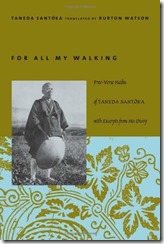Book Review – For All My Walking by Taneda Santōka (Trans. Burton Watson)
 Taneda Santoka was a tragic figure - his mother and brother suicided, his father squandered the family fortune and Taneda himself battled an alcoholism that he knew had the better of him.
Taneda Santoka was a tragic figure - his mother and brother suicided, his father squandered the family fortune and Taneda himself battled an alcoholism that he knew had the better of him.
This tragic life, Burton Watson suggests, is part of the reason he is reserved a place in Japanese literary history (the Japanese apparently have an appreciation for those that mess up their lives completely) the other is his contribution to and continuing development of, Japanese Free Verse Haiku (Haiku without Kigo and syllable* restriction).
For All My Walking is a collection of Taneda’s daily diaries and the Haiku he wrote, including travels that he intended would echo Basho's own . The Haiku are presented in chronological order and when taken from published collections Watson notes this. Interspersed between the Haiku are diary entries which Watson has included to give some context to the poems and to give us a sense of the poet.
In that regard I find similarities with earlier works such as Basho’s Narrow Road to the Interior but perhaps this owes something to Watson’s arrangement rather than the intention of the poet ie Watson’s selections create a narrative whereas Basho creates his own.
Basho is more reserved and in the main directs his gaze outward. Taneda’s diaries seem to focus more heavily on himself, his battle with alcoholism and his struggle to maintain a living.
In presenting the Free Verse Haiku Watson has this to say:
My own interest in Santōka’s work centers more on the poetry itself, particularly the manner in which it experiments with different poem lengths and syntactic patterns, and the challenge that these present to the translator. Since free-style haiku do not adhere to the conventional 5–7–5 sound pattern, the translator is free to break them more or less wherever he or she wants or, like Hiroaki Sato in his translations of Ozaki Hōsai’s free-style haiku, to translate them as a single line in English. I have regularly broken my own translations into two or three lines in the hope that this division will help readers grasp the syntax of the poem and slow down the reading.
Modern Japanese in nearly all cases requires more syllables or sound symbols to express a given idea or image than does modern English, and so English translations of Japanese haiku, if not deliberately padded, will almost inevitably turn out to be briefer in wording than the originals. And when confronted with a poem such as Santōka’s haiku “oto wa shigure ka,” one comes out with something looking like this:
that sound
the rain?
My initial impression of the Haiku were that they felt a bit flat. By the end of the book, whether it was through sympathy with Taneda or familiarity, I did gain some appreciation. He reads at times like English Language Haiku (possibly because of the lack of Kigo or allusion) or perhaps I should say that some English language Haiku start to resemble Taneda’s work.
I can’t help but feel though that the change from Traditional to Free Verse Haiku would be more keenly felt in the original Japanese and that in translating, quite a lot is lost. Take for example the beautiful sound that the poem above makes in Japanese, which owing to its brevity can’t really be replicated in English.
Taneda can be extremely self involved at times and at others he captures what is going on around him in reverent detail:
July 11, 1938. Today is the day the ashes of the dead soldiers arrive. I caught the 10 o’clock bus to Yamaguchi…. At Yamaguchi Station, a guard of honor, families of the deceased, onlookers standing around under the glaring summer sky, waiting, myself among them. Hot, hot! Now and then, spatters of rain, like tears from the sky.
A little past twelve the train arrived. Ah—two hundred and thirty or forty some dead, a “triumphal return” with no hurrahs, a pitiful scene. Alongside the white boxes, two or three memorial bunches of bellflowers, two or three pigeons appearing, circling in the sky above. Sounds of muffled weeping, muted volley of rifles, sad notes of bugles, as the procession moves solemnly through the crowd, taking the dead men back to their home unit.
213
(“Home Front”)
valiantly—that too
pitifully—that too
white boxes
214
(“Home Front”)
drops of sweat
plop-plopping
on blank white boxes
215
(“Home Front”)
town festival
as bones
coming home for it?
216
(“Home Front”)
scarecrow too
bravely waving
the Rising Sun flag
Taneda is still popular in Japan today, so I think that in addition to suggesting he be read to improve a Haiku poet’s historical knowledge, there’s an argument to be had for studying the work of someone who must surely still have an effect on the writing of modern Haiku.
*Note I am using the term syllable loosely here to represent the Japanese symbol sounds
Comments
Post a Comment